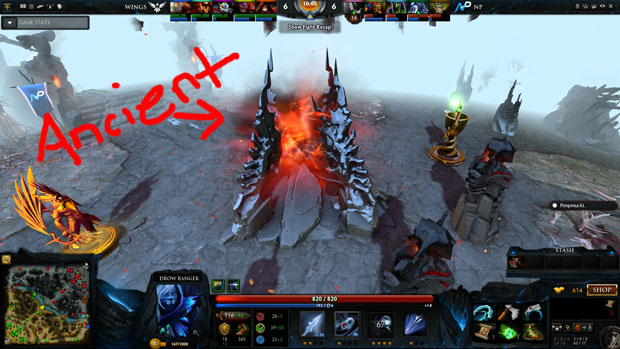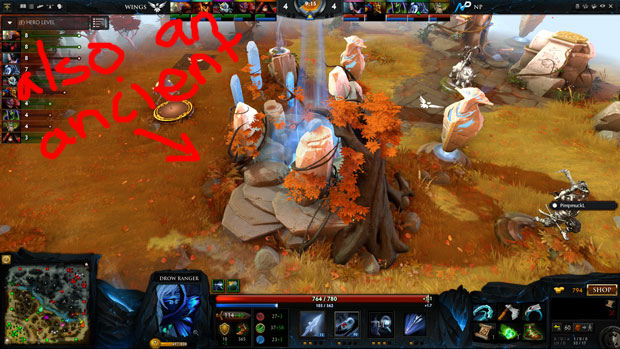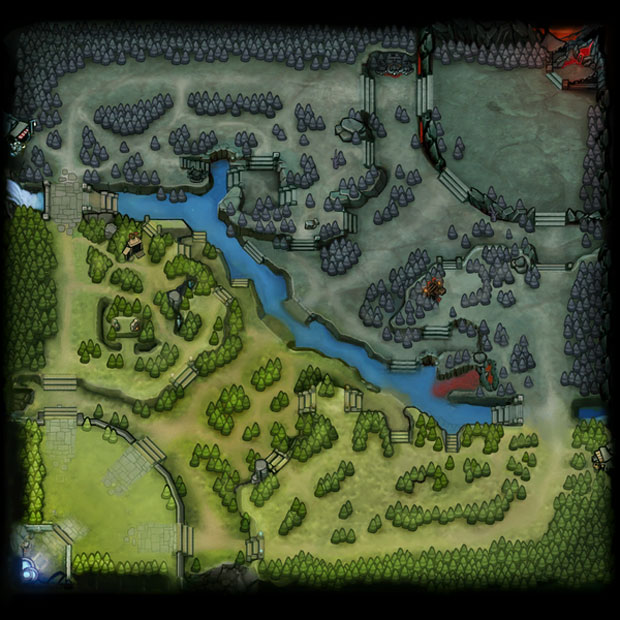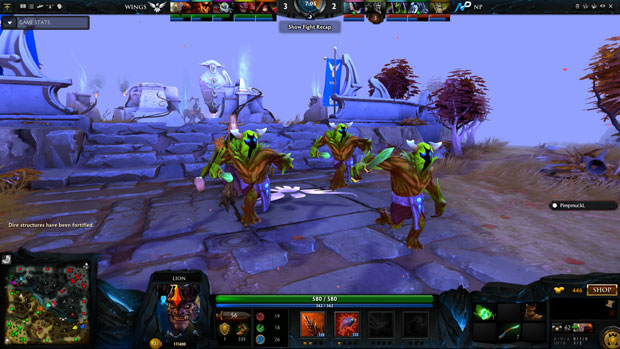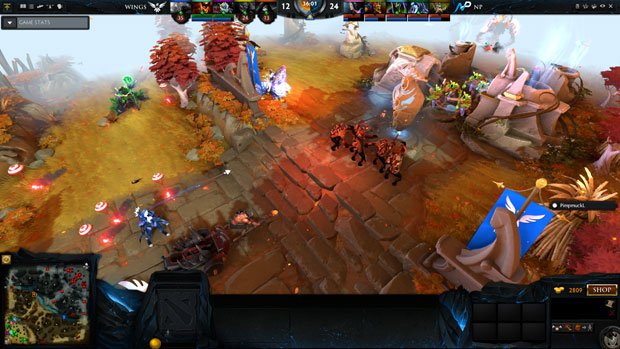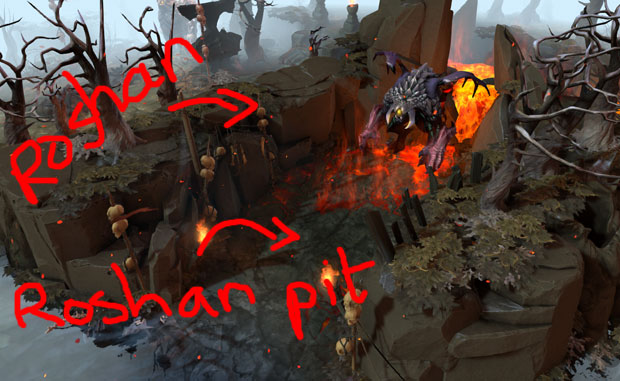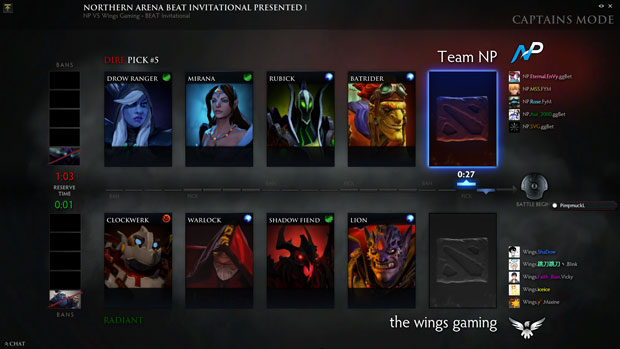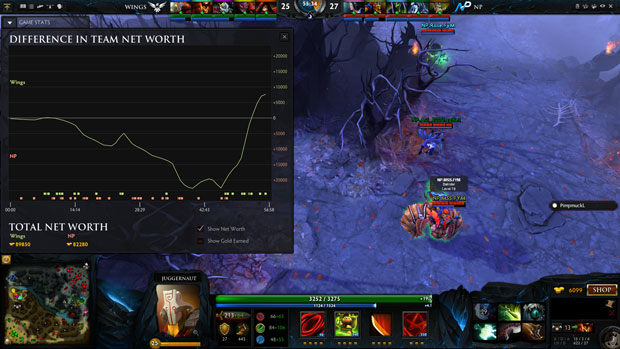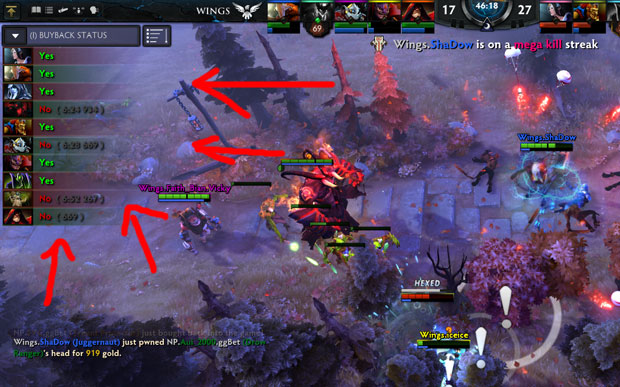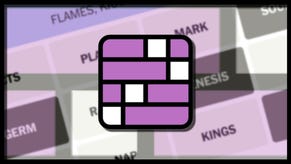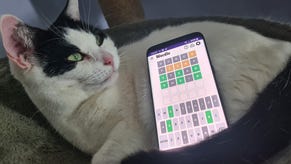How to watch Dota 2
Top tips for watching pro esports
Dota 2 [official site] begins its next season of multi-million dollar Major tournaments in earnest on December 3, with the Boston Major set to take over the lavish Wang Theatre. While only a relatively small number of viewers will be able to fit inside to see the ridiculously monied spell-storms up close, potentially millions more will be watching via stream – including you, if you so desire.
Indeed, watching top-tier Dota can be even more entertaining, and significantly less aggravating, than playing it yourself. Yet surely you’d need at least a decent amount of hands-on experience with the game to derive any understanding, let alone enjoyment, from spectating others?
Fret not. It is a remarkably complex (and ever-changing) game, but it’s also surprising easy to pick up the basics when it’s just ten heroes duking it out, while a team of casters and analysts spell the action out over mic. Better yet, read this guide – a primer on both the essentials and the intricacies of a game of Dota 2, beamed through the prism of pro match viewership like Tinker’s Aghs Q!
The objectives
At its core, Dota 2 is a game about the accumulation and application of resources. There are two teams of five player-controlled heroes each, and while the ultimate goal is to break though the enemy team’s base defences and destroy their Ancient within (it's the main glowing building in each team's spawn area), the ease of getting there is determined by how quickly you can amass experience (XP) to level up your spells and gold to buy items which grant stat bonuses and/or new abilities – especially relative to the other team.
This is mainly achieved by killing creeps which are weak AI-controlled beasties. You'll find them either running from their respective team’s base towards the enemies’ along the three main pathways (lanes), or chilling out in various camps dotted around the map. Simply put, the faster your team collects gold and XP by killing creeps and heroes ("farming"), the better your chances of successfully knocking down the enemy Ancient – as well as of winning any hero-on-hero teamfights along the way.
The map
The map is divided into three lanes, linked together by smaller winding paths which cut through wooded areas (the latter bits are collectively referred to as “the jungle”). There's also a long river cutting diagonally across the middle of the map from the top left to the bottom right. The side of the river towards the top right with all the dead trees and sad colour palette is the Dire side. The bottom left is the Radiant side and is green and vibrant.
Pushing your way down at least one (and ideally all three) of these lanes is crucial to victory because those are the routes into the enemy base.
As mentioned above, these lanes are thus where small groups of creeps will spawn at regular intervals and then mosey on down, Lemmings-style, until they’re killed off by either a hero or the opposing set of creeps. The lanes are also defended by a series of towers; defensive turrets which must be destroyed in sequence to open up a path into the enemy base.
The middle lane is referred to as the mid lane, the one which runs up the left side of the map and then along the top is called the top lane and the one which runs along the bottom of the map and then up the right side is called the bottom or bot lane. The map is rectangular so the creeps will only meet in the dead centre of the river in the mid lane. In the top lane they meet slightly closer to the Dire team's first tower so the Dire team is slightly better protected. That's why this bit is referred to as the Dire side's safelane (and the Radiant side offlane). The opposite is true for the bottom lane. That's the Radiant safe lane and the Dire offlane.
The base itself consists of the Ancient, some high-level towers and a set of two ‘barracks’ for each lane. In professional games as in regular play this tends to get shortened to "rax" and gets used as a verb. To rax someone is to destroy the barracks in that lane.
These are effectively the creep spawn points, and are an optional but hugely advantageous objective to destroy; doing so won’t stop the enemy creeps spawning, but will make your own creeps in that lane stronger. Smashing all six enemy barracks will give your team "mega creeps", which turns your little minions into a far beefier, deadlier force and helps make your team harder to fight against. Mega creeps can easily overwhelm even a well-farmed team if they're not killed quickly enough. Mega creeps also gets used as a verb so if you hear that a team has been "mega-creeped" it means they are fighting against those waves of super-minions.
The entire base is on slightly higher ground than the surrounding area, making it more difficult for the attackers to see into and easier for defenders to defend. What that means is that if you're standing at the top of the little staircases which lead into the base your character can see the area below but if you're standing at the foot of the stairs you can't naturally see what's at the top. If you're lower down you also have a chance to miss your shots on higher-up targets, so that's a big part of why breaking into the base can be really tricky.
The jungle, meanwhile, is home to those other groups of creeps – the ones who aren't aligned to a particular team and who stand about in camps rather than running towards each other. They will attack anyone and anything that wanders too close or attacks them and are a valuable source of gold and XP. They respawn at timed intervals so dealing with these camps involves being aware of the timings and knowing how to make the rounds of these camps efficiently.
There are two special camps on either side of the river which contain particularly strong monsters called Ancients (not to be confused with the Ancient which is the giant inanimate rock that you're protecting in your base). The Ancient creeps provide much bigger bounties when murdered.
The biggest creep of all is Roshan, who lives in a pit (affectionately known as “the Rosh pit”) towards the southeast end of the river. Killing him is incredibly tough, and he only respawns every 8-11 minutes instead of every minute like normal creep camps. He is a big deal because he drops the Aegis of the Immortal item when he dies. It's a one-time-use item that allows a slain hero to near-instantly revive so that hero essentially gets two lives in a fight. After his third death in a game, Roshan will also start dropping the mighty Cheese item, which immediately refills a LOT of health and mana when munched upon. Pro teams will commonly look to claim both of these items as insurance policies before attempting to breach the high ground of an enemy base, such is the difficulty of the latter.
The roles
Generally speaking, each of the five players on a team will fill a certain role, sometimes referred to by a number designating their priority for farming gold and XP.
The 1 position, for instance, is the carry. They’ll start off weak but will be allowed by the rest of the team to take the most killing blows (“last hits”) on creeps and, preferably, enemy heroes. These last hits grant them a gold bounty as well as experience for the kill. This allows them to become much, much stronger as the game progresses, ultimately becoming the main damage dealer. This happens because experience lets you level the character up and thus unlock and strengthen their abilities as well as buying useful items to amp up the damage they can do.
The commentary on this video might seem confusing but keep an eye on Chu "Shadow" Zeyu. He's playing Slark - the weird fish creature with two blades who does somersault jumps. You can see that he has farmed up and become the main damage dealer, capable of smashing through enemy health bars:
The 2 position is the midlaner, who’ll spend the early game competing with their opposite number for last hits in the middle lane. The middle lane is the shortest and thus the creeps meet each other quickest. By taking advantage of that speedy meetup and leaving a character alone on this lane (meaning they aren't sharing the experience earned with any allies) lets them get a boost in terms of levels early on in the game. Midlaners can be focused on dishing out damage, but their skillsets may also allow them to take a utility-based role, stunning enemies or otherwise preventing them from using spells effectively during fights.
Here's mid-laner Syed "Sumail" Hassan as zippy lightning-themed hero, Storm Spirit:
The 3 position offlaner perhaps has the hardest job; they’ll usually have to be in a lane on their own against both the enemy carry and one of their supports (more on supports in a sec), but will still need to find the gold and experience needed to become an effective force in the game. Since offlaners need to have high impact but are thought of as more expendable than the other two ‘core’ roles (the carry and mid) they’ll commonly take “initiation” duties. That means being the first to dive into a fight so that it starts on their own team’s terms, even if it increases the offlaner's own chances of death.
This is David "MoonMeander" Tan romping around having a jolly time as offlaner and initiator Earthshaker. He uses the blue knife - a blink dagger - to suddenly appear next to enemies and start fights:
The three cores are backed up by two support players. The 4 position support has a bit of flexibility in their approach – they could roam around, launching surprise attacks on laning foes, they could sit in the jungle farming neutral creeps for themselves, or park themselves permanently next to the offlaner to give them an easier time. Maybe a mixture of all of those things.
The 5 position is much more static, typically babysitting the carry in lane (for example, attacking the enemy offlaner and forcing them away from the vulnerable carry). Position 5 has the lowest gold/XP priority because what they bring to the game tends not to revolve around needing expensive items or lots of levels in their abilities. For this reason they tend to be tasked with buying ‘support items’ like the courier (which ferries newly-bought items to players from the base shop) and wards (which grant temporary vision of otherwise-unseen areas of the map). They tend to be about enabling other characters to shine and facilitating control of the map.
Here's a video showing Akbar 'Sonneiko' Butaev as Winter Wyvern (that blue dragon) protecting the core players. You'll see him using cold embrace which is the spell that puts allies in an ice cocoon to heal them and to block one type of damage:
Dota 2 is a lot more flexible than most MOBAs in how each role plays out; you can, and probably will, see pro teams do seemingly weird stuff like have a support character permanently in their mid lane with their 2 position player, or the 4 player pick a hero with invisibility powers which let them ignore creeps completely and wander around the enemy’s half of the map looking for ambush opportunities. Some games will have a jungler (a hero dedicated to efficiently clearing those jungle camps) and other games will get rid of that role entirely. The underlying objectives stay the same, though: cores amass resources, supports help cores amass resources.
The lingo
Even if you’ve played a bit of Dota, the several volumes’ worth of jargon involved in it can be overwhelming, especially when certain casters blurt them out at 300 words per minute. This isn’t anywhere near a complete glossary (we have a beginner's glossary for an expanded vocab lesson and there's a Wiki if you need more answers) but there are a few key terms you should know before settling down to watch the pros play.
Aggro trilane: A laning lineup consisting of the carry and both supports all occupying their side's offlane. It's a bullying, aggressive playstyle involving three people in a lane, hence the name.
Defensive trilane: This one is a carry and two supports occupying their team's safe lane. This one is more about making extra sure the position 1 is able to farm safely.
Base race: The rare but thrilling occasion where both teams end up making direct attacks on their respective enemy Ancients at the same time.
Feeding: Dying to an enemy team in entirely avoidable circumstances, granting them easy gold and XP. Often accompanied by Twitch chat spam and variants on the phrase “ENVY WHAT ARE YOU DOING”.
Gank: A surprise attack on an enemy hero or heroes, typically reliant on at least one attacker approaching unseen.
Juke: Dodging a spell or evading an enemy. Lengthy descriptions of the manner in which a successful juke occurs, as well as declarations of admiration for the skill involved in said juke, can be abbreviated by simply shouting “the jukes!”
Meta: The current trends and state of the game which spread beyond individual games – everything from which heroes are considered strong and weak to whether you try to destroy towers early or late.
Pocket strat: Pocket strats or strategies are ideas or hero picks a team has kept secret in order to pull them out of their "pocket" and surprise their opponents.
Rotation: During the laning stage, a hero leaving their own lane (whether by walking or using a teleportation scroll) to assist in another, whether it’s to help kill an enemy or defend an ally.
Split push: Pushing means applying pressure to a lane, usually by damaging buildings and making it so your creeps can get further towards the enemy base. Split pushing is doing that on multiple lanes. Split pushing often involves mobility and stealth so you can apply the pressure and then get out before you get yourself killed, especially if your teammates are occupied elsewhere. That style particularly is known more disparagingly as “rat Dota”.
Throne: Another name for the Ancient.
The drafting phase
If, like me, you’re too much of a coward to play anything other than Unranked All Pick, you may not be familiar with the drafting stage of each game. And yet, games can be won or lost on this screen where teams take it in turns to both pick heroes for themselves and ban heroes from being chosen at all.
Tournaments generally use Captains Mode which gives one player on each team the ability to pick and ban heroes, either selecting them for their own side or removing them from the pool for either team. The current order goes:
Team A ban
Team B ban
Team A ban
Team B banTeam A pick
Team B pick
Team B pick again
Team A pickTeam B ban
Team A ban
Team B ban
Team A banTeam B pick
Team A pick
Team B pick
Team A pickTeam B ban
Team A banTeam A pick
Team B pick
You don't need to memorise that or anything. Just note that the activity in one phase impacts the next phase and each pick or ban imparts a little information about how the team want to play the game itself. You should also note that at a couple of points in the draft a team gets to take two actions one after the other. The double pick is a good time to pick up a combination of heroes which might otherwise be blocked, the ban followed by a pick lets you ban something which counters the hero you like and then pick that hero you like before the other side can interfere.
Naturally, at the pro level this phase involves a lot of knowledge about current generally strong heroes and the opposing squad’s preferences and playstyles, with more than a little bit of mindgames thrown in. Great drafters can use their early picks not just to secure must-have heroes (whether it’s a meta-favoured choice or a comfort pick for a certain team member), but to bait rivals into picking what seems like a strong countering option, only for that counter to be countered itself with the next pick.
The good news, if you’re not also the Alexander the Great of wizard fight tactics, is that pro game broadcasts will generally have one or a few talented analysts to talk through the draft as it happens, pointing out strengths and weaknesses of heroes as well as outlining why the players are making particular choices. Still, when you start to get comfy with the game it is quite fun to try guessing what comes next, especially when it comes to each team’s fifth and final picking phase. This is where you’re most likely to see surprise/non-meta picks and pocket strategies come together, as the enemy will have little or no wiggle room to adapt their own choices around it.
[When I was learning I used the draft phase to look up the heroes on a Dota app on my phone and remind myself of their basic ability set - Pip]
The game itself
Once the game gets underway, you can just sit back and watch, but it’s worth learning which bits of information to keep an eye on in order to truly appreciate how the game is progressing. The most obvious is the kill counter at the top of the screen, but really, this is actually one of the less helpful metrics.
The net worth graph, which you’ll often see brought up after a hero brawl, paints arguably the most accurate picture of a game’s progression. Resources are everything, so the team with more gold (in their pockets or invested in items) will almost always have the advantage. A total net worth difference of less than 5K is a very narrow lead, and can be easily turned around with one good teamfight or a few single-hero pickoffs, whereas a 10K-plus advantage usually signifies one team having the game firmly in their control. Most games keep things even for the first ten minutes or so, where both teams focus on simply sitting in lane and hitting creeps rather than grouping up to break down towers, but teams can build up advantages quickly if their supports make numerous successful gank attempts. Indeed, this is a popular strategy amongst more aggressively-minded teams.
On an even more micro level, you can judge how well (or badly) individual players are doing by their item progression. Core players will need a pair of movement speed-increasing boots plus one key item (such a Battle Fury for Anti-Mage, which grants him farm-accelerating area of effect cleave damage which lets him mow through those waves and camps of creeps) by about the 15 minute mark. Gold-starved supports often won’t get boots of their own until 10 minutes in if they die frequently enough.
As the game goes later and later, something called buyback status becomes paramount. For a steep gold fee, buyback allows a hero to respawn at base after dying without having to wait out the usual death timer – though if they die again, it will take even longer to come back to life, and they won’t be able to buyback again for five minutes. A buyback which results in such a death gets referred to as a "dieback".
Whether you have the ability to buyback can make or break a base defence, as a team with full buyback availability means the attackers may effectively need to kill them all twice (though this would do serious damage to the besieged team’s economy). You’ll often see teams “forcing the buyback” – feinting a high ground push so that a dead enemy decides to spend their gold to revive and defend, then making a safe retreat.
That about covers it – though do have a gander at professional analyst, panellist and Dota weatherman Kevin ‘Purge’ Godec’s excellent guide if you want to know more about individual game mechanics. Otherwise, stay tuned for a close look at the Boston Major itself (including the sixteen teams involved) closer to the December 3rd kickoff.


